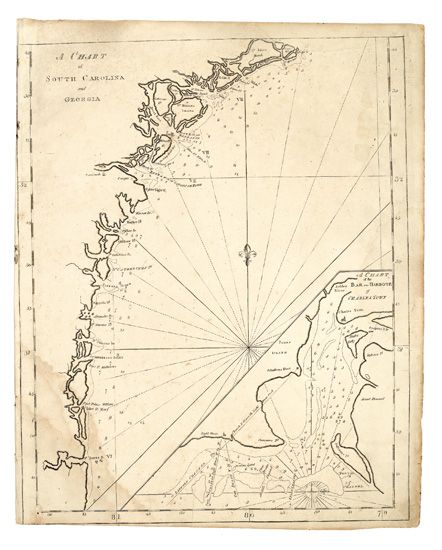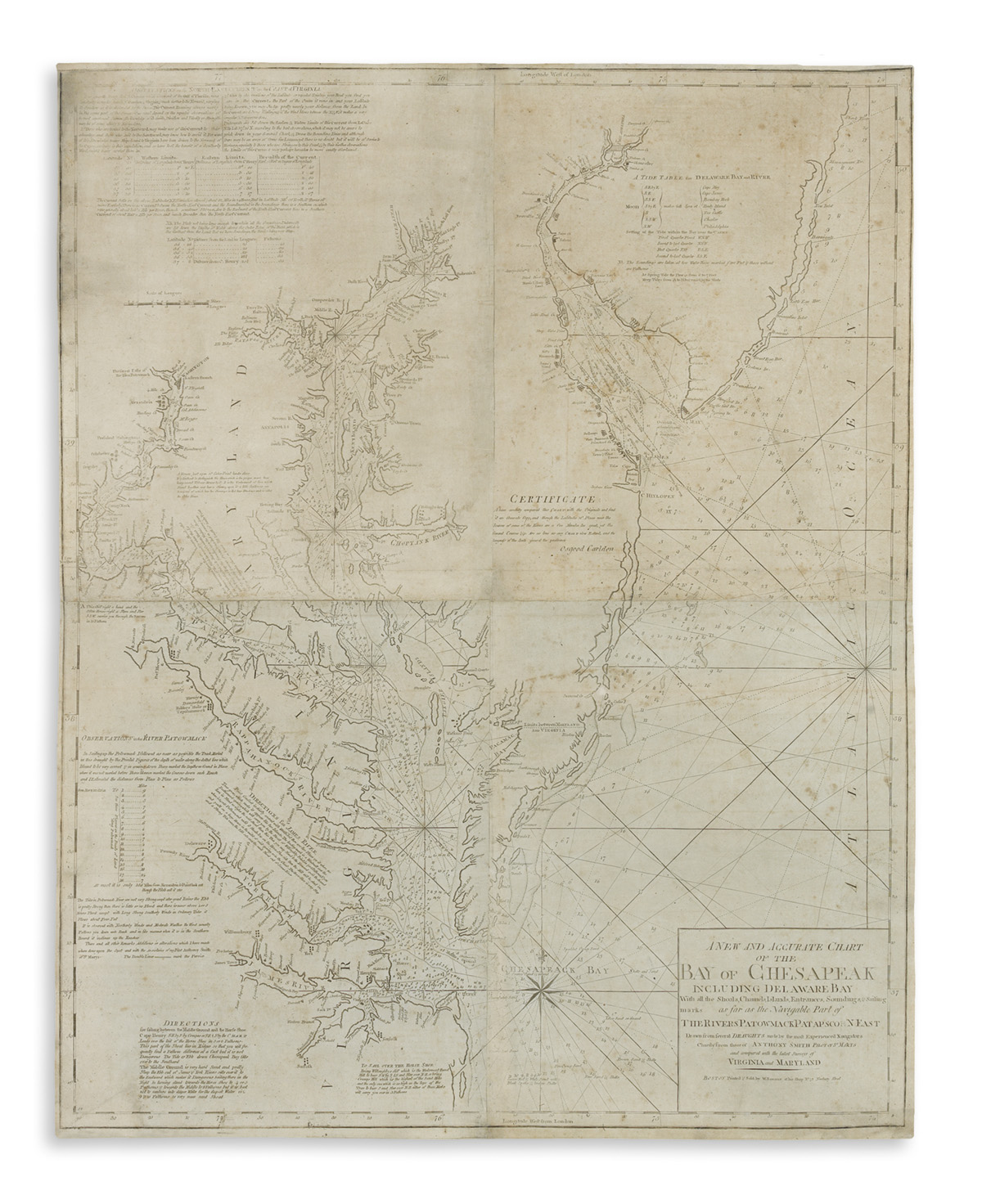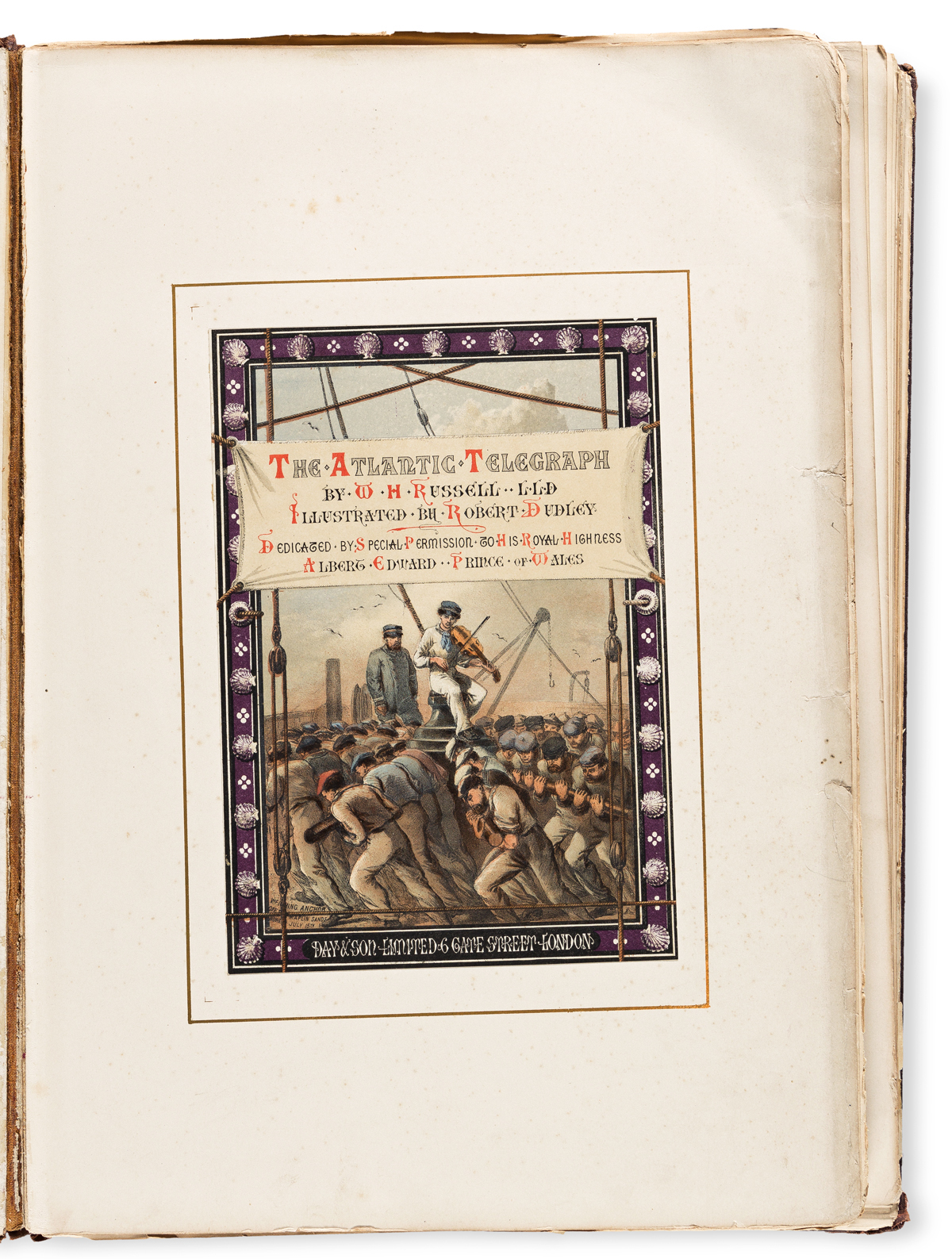NORMAN, William. A Chart of the Coast of America from Wood Island to Good Harbour from Hollands Surveys . [Boston: William Norman, [1791-1801].
NORMAN, William. A Chart of the Coast of America from Wood Island to Good Harbour from Hollands Surveys . [Boston: William Norman, [1791-1801]. Engraved sea chart on two joined sheets, 540 x 860 mm sheet size. (Some chipping and light wear along lower margin with loss of outer border.) State two of the second sea chart of the Maine coast to be published in America. State one lacked the title, which Wheat & Brun identify as first appearing on state two, which first appeared in the 1803 edition of the atlas. But this example of state two was published in the exceedingly rare 1801 edition, unknown to Wheat & Brun, and it is possible that the alteration was undertaken before the close of the eighteenth century. The American Revolution brought an end to Britain's leading role in the mapping of America. The task then fell to the American publishing industry, still in its infancy, but with firsthand access to the new surveys that were documenting the rapid growth of the nation. In particular, there was a need for nautical charts for use by the expanding New England commercial fleets. The first American marine atlas, Mathew Clark's A Complete Set of Charts of the Coast of America , was published in Boston in 1790. Two of Clark's charts had been engraved by John Norman who was inspired to launch his own enterprise. On Jan. 1, 1790, Norman advertised in the Boston Gazette the publication of A New General Chart of the West Indies , with a notice stating that he was currently engraving charts of all the coast of America on a large scale. These were assembled and published as The American Pilot (Boston, 1791). Norman's Pilot , the second American marine atlas (and the second American atlas of any kind) marked an advance over the earlier work of Mathew Clark. New editions of Normans' appeared in 1792 and 1794, and after John Norman's death his son, William, brought out editions in 1794, 1798, 1801, and 1803. Despite the seemingly large number of editions, The American Pilot is among rarest of all American atlases, and one of only a small handful published in the 18th century. Wheat & Brun (pp.198-199) locate just ten complete copies for the first five editions: 1791 (Huntington, Harvard); 1792 (LC, Clements); 1794 (1) (LC, JCB, Boston Public); 1794 (2) (Yale); 1798 (LC, Boston Public). According to American Book Prices Current , no copies of this map have appeared on the market in at least thirty years, nor have any copies of any edition of Norman's American Pilot . Suarez, Shedding the Veil , p.164 (ref); Wheat & Brun 166.
NORMAN, William. A Chart of the Coast of America from Wood Island to Good Harbour from Hollands Surveys . [Boston: William Norman, [1791-1801].
NORMAN, William. A Chart of the Coast of America from Wood Island to Good Harbour from Hollands Surveys . [Boston: William Norman, [1791-1801]. Engraved sea chart on two joined sheets, 540 x 860 mm sheet size. (Some chipping and light wear along lower margin with loss of outer border.) State two of the second sea chart of the Maine coast to be published in America. State one lacked the title, which Wheat & Brun identify as first appearing on state two, which first appeared in the 1803 edition of the atlas. But this example of state two was published in the exceedingly rare 1801 edition, unknown to Wheat & Brun, and it is possible that the alteration was undertaken before the close of the eighteenth century. The American Revolution brought an end to Britain's leading role in the mapping of America. The task then fell to the American publishing industry, still in its infancy, but with firsthand access to the new surveys that were documenting the rapid growth of the nation. In particular, there was a need for nautical charts for use by the expanding New England commercial fleets. The first American marine atlas, Mathew Clark's A Complete Set of Charts of the Coast of America , was published in Boston in 1790. Two of Clark's charts had been engraved by John Norman who was inspired to launch his own enterprise. On Jan. 1, 1790, Norman advertised in the Boston Gazette the publication of A New General Chart of the West Indies , with a notice stating that he was currently engraving charts of all the coast of America on a large scale. These were assembled and published as The American Pilot (Boston, 1791). Norman's Pilot , the second American marine atlas (and the second American atlas of any kind) marked an advance over the earlier work of Mathew Clark. New editions of Normans' appeared in 1792 and 1794, and after John Norman's death his son, William, brought out editions in 1794, 1798, 1801, and 1803. Despite the seemingly large number of editions, The American Pilot is among rarest of all American atlases, and one of only a small handful published in the 18th century. Wheat & Brun (pp.198-199) locate just ten complete copies for the first five editions: 1791 (Huntington, Harvard); 1792 (LC, Clements); 1794 (1) (LC, JCB, Boston Public); 1794 (2) (Yale); 1798 (LC, Boston Public). According to American Book Prices Current , no copies of this map have appeared on the market in at least thirty years, nor have any copies of any edition of Norman's American Pilot . Suarez, Shedding the Veil , p.164 (ref); Wheat & Brun 166.











Testen Sie LotSearch und seine Premium-Features 7 Tage - ohne Kosten!
Lassen Sie sich automatisch über neue Objekte in kommenden Auktionen benachrichtigen.
Suchauftrag anlegen